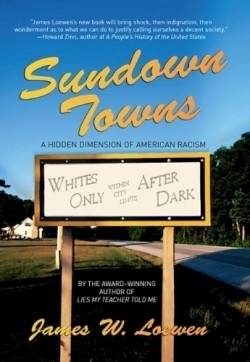Sundown Towns
A Hidden Dimension of American Racism
- 2005 INDIES Finalist
- Finalist, History (Adult Nonfiction)
If slavery is white America’s greatest crime committed against Black America, then “sundown towns” might be its best-kept dirty secret. Sundown towns are racist communities that prevented African Americans—by illegal regulations, intimidation, or violence—from remaining in town after sunset. One such town discussed prominently here is Anna, Illinois, whose name, as the “joke” goes, stands for “Ain’t No N—s Allowed.” This reference became popular after Anna’s expulsion of its African American population in 1909, following a public lynching.
The author presents an historical and sociological investigation of these towns and suburbs, which numbered as many as 25,000 and were located in all regions of the United States, largely excepting the South. Surprisingly, after the Civil War, the South did not create sundown towns, because it depended on the cheap and readily available labor of African Americans.
Loewen, the author of the best-selling Lies My Teacher Told Me and Lies Across America, is a retired sociologist from the University of Vermont. He is at his best when he discusses the false claim of history texts that frame the civil rights record as one of slow but steady progress from the Civil War to the present. Instead, the author posits a convincing argument that, following the Reconstruction era, in a period from 1890—1940 that he calls “The Nadir,” African Americans endured a ruthless backlash in which they were stripped of their citizenship, and sundown towns flourished. In place of the “Great Migration,” the author depicts a grim portrayal of a “Great Retreat,” in which the nation’s Blacks were forced out of sundown towns throughout America and into what became inner-city ghettos.
Included are many interviews, which strengthen the book, with sundown-town refugees who tell grim stories about such communities as Springfield, Illinois, the birthplace of Abraham Lincoln, which went sundown after the lynching of a Black man accused of raping a white woman. Several times, African Americans were forced out of these towns following race riots over incidents that were frequently contrived.
This book is too long, due to its repetition and its many statistics; a more streamlined account would have been as powerful. Also, the author’s call for a “Residents Rights Act,” modeled on the Voting Rights Act, as a means to encourage integration, is proposed in an era when federal acts are frequently regarded as unfounded mandates or intrusive abuses of federal power. However, this investigation is important for revealing the little-known history of sundown towns, and the author admirably substantiates his claim that “we need to know about sundown towns to know what to do about them.”
Disclosure: This article is not an endorsement, but a review. The publisher of this book provided free copies of the book to have their book reviewed by a professional reviewer. No fee was paid by the publisher for this review. Foreword Reviews only recommends books that we love. Foreword Magazine, Inc. is disclosing this in accordance with the Federal Trade Commission’s 16 CFR, Part 255.

